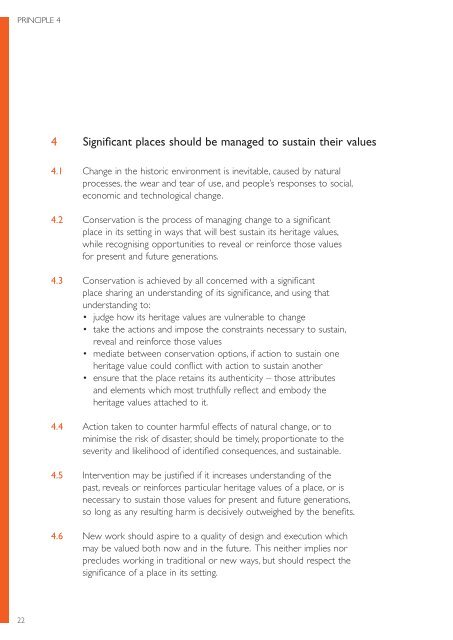Conservation Principles, Policies and Guidance - English Heritage
Conservation Principles, Policies and Guidance - English Heritage
Conservation Principles, Policies and Guidance - English Heritage
You also want an ePaper? Increase the reach of your titles
YUMPU automatically turns print PDFs into web optimized ePapers that Google loves.
PRINCIPLE 4<br />
22<br />
4 Significant places should be managed to sustain their values<br />
4.1 Change in the historic environment is inevitable, caused by natural<br />
processes, the wear <strong>and</strong> tear of use, <strong>and</strong> people’s responses to social,<br />
economic <strong>and</strong> technological change.<br />
4.2 <strong>Conservation</strong> is the process of managing change to a significant<br />
place in its setting in ways that will best sustain its heritage values,<br />
while recognising opportunities to reveal or reinforce those values<br />
for present <strong>and</strong> future generations.<br />
4.3 <strong>Conservation</strong> is achieved by all concerned with a significant<br />
place sharing an underst<strong>and</strong>ing of its significance, <strong>and</strong> using that<br />
underst<strong>and</strong>ing to:<br />
• judge how its heritage values are vulnerable to change<br />
• take the actions <strong>and</strong> impose the constraints necessary to sustain,<br />
reveal <strong>and</strong> reinforce those values<br />
• mediate between conservation options, if action to sustain one<br />
heritage value could conflict with action to sustain another<br />
• ensure that the place retains its authenticity – those attributes<br />
<strong>and</strong> elements which most truthfully reflect <strong>and</strong> embody the<br />
heritage values attached to it.<br />
4.4 Action taken to counter harmful effects of natural change, or to<br />
minimise the risk of disaster, should be timely, proportionate to the<br />
severity <strong>and</strong> likelihood of identified consequences, <strong>and</strong> sustainable.<br />
4.5 Intervention may be justified if it increases underst<strong>and</strong>ing of the<br />
past, reveals or reinforces particular heritage values of a place, or is<br />
necessary to sustain those values for present <strong>and</strong> future generations,<br />
so long as any resulting harm is decisively outweighed by the benefits.<br />
4.6 New work should aspire to a quality of design <strong>and</strong> execution which<br />
may be valued both now <strong>and</strong> in the future. This neither implies nor<br />
precludes working in traditional or new ways, but should respect the<br />
significance of a place in its setting.

















